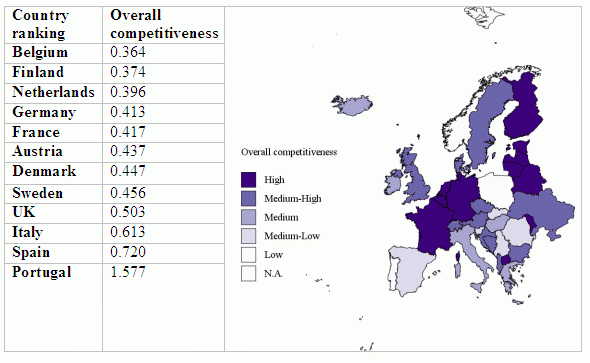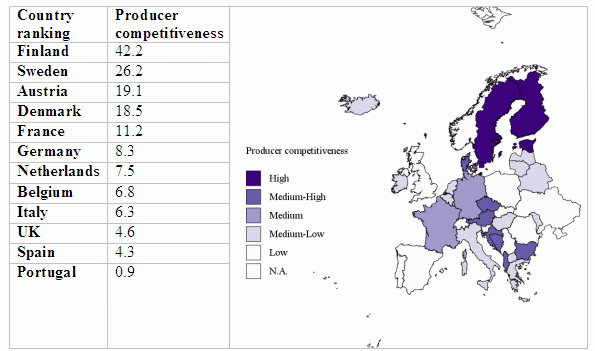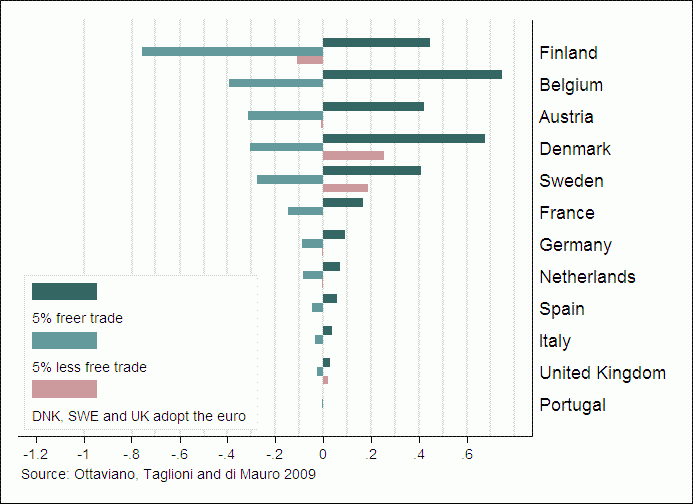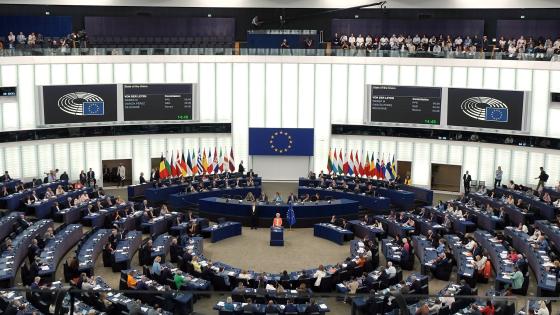In recent years, much attention has been devoted to the impact of a single currency on trade volumes. Lower trade costs, however, matter over and beyond their effects on trade flows – as less productive firms are forced out of business by tougher competitive conditions of international markets, economic integration fosters lower prices and higher average productivity.
Tougher competition is a channel for gains from trade
A rapidly growing literature has highlighted evidence suggesting that tougher competition and the associated reallocation of resources from less to more efficient firms is a channel for gains from trade . These facts have prompted the recent development of new trade theories that show how international trade integration has a positive impact on aggregate productivity through the expansion of the most productive firms. In particular, modelsin which international differences in the “toughness of competition” are endogenous are able to replicate many real world mechanisms, showing that the benefits from trade stem from fostering countries’ specialisation in sectors in which they are more efficient, enabling a richer product variety, weakening the market power of firms, enhancing the exploitation of economies of scale, and improving efficiency by causing the least efficient firms to exit. Recent empirical research demonstrates the importance of properly accounting for all these channels in a multi-country and multi-sector setting is demonstrated to be very important by.
In the wake of this literature, we calibrate a state-of-the-art trade model to assess the impact of the adoption of the euro on the productivity and international competitiveness of firms belonging to different European countries and industries. This exercise also allows us to evaluate the competitiveness of European manufacturing firms in terms of an efficient use of available inputs. In so doing, we derive a ranking of European countries in terms of the cost effectiveness of the firms located therein – which is then used as a measure of the “overall competitiveness” of the corresponding countries.
Competitiveness rankings in Europe
By calibrating the model on 12 manufacturing sectors across 12 EU countries for the years 2001-2003, we are able to quantify the collective competitiveness of firms belonging to different countries. Here, competitiveness means an efficient use of available inputs, given the institutional and market set-up in which firms operate. The geographical pattern of countries’ overall competitiveness is portrayed in Figure 1, where the most competitive countries appear to be those that are at the heart of Europe – such as Belgium, the Netherlands and Germany – and Finland. This outcome is consistent with the theoretical prediction that countries that are large or easily accessible to firms from trading partners should exhibit a tougher competitive environment and stronger selection. Italy, Spain and Portugal are at the bottom of the table, likely due to their less-central location and a possible technological disadvantage, which is associated with high entry costs in new sectors.
Figure 1. Overall competitiveness
Our framework also allows us to assess whether a country’s competitiveness is due to geography or factors that can be influenced by policy, such as technological and institutional setup. A so-called “index of producer competitiveness” aims to measure the ability of a given country to generate low-cost firms in a given sector, abstracting from productivity differences that stem from country-specific market size, sector-specific product differentiation, sector-specific elasticity of the extensive margin, and delivery costs specific to the sector, the country of origin and the country of destination. We thereby obtain an indicator of competitiveness that solely depends on technology and institutional factors.
According to this second ranking (see Figure 2), Sweden becomes the second most competitive country in terms of producer competitiveness. This implies that the country shows a strong technological advantage and/or a good institutional environment, but it has a disadvantage in terms of location (since it ranks only eighth in terms of overall competitiveness). Hence, being at the periphery does not represent a problem per se, unless it is compounded by clear relative technological and institutional disadvantages that hamper firm productivity. In this context, it is worth noticing a rather substantial improvement in the ranking of Denmark, in terms of producer competitiveness compared to its ranking in terms of overall competitiveness.
The opposite is true for Belgium, Germany and the Netherlands, whose rankings in terms of producer competitiveness are substantially lower than those in terms of overall competitiveness. This signals weak technological advantages and/or a worse institutional environment, only partially offset by their central location. Finally, Portugal and Spain – and, to a lesser extent, Italy and UK – are consistently at the bottom of the competitiveness ranking, no matter how this is measured, suggesting the presence of parallel negative impacts of geographical location, market access, technological and institutional (dis)advantages.
Figure 2. Producer competitiveness
What if Denmark, Sweden and the UK had joined the euro area in 2003?
The calibrated model can be easily used to simulate the impact on competitiveness of a wide range of policy decisions. Here we focus on the decision of Denmark, Sweden, and the UK to remain outside the euro area and the question of whether their competitiveness has suffered from facing the international trade frictions associated with the use of multiple currencies. We do so by simulating counterfactual scenarios where we change the estimated level of trade resistance between countries with and without the common currency.
In order to proxy for the impact of the euro on trade frictions, we rely on the findings from the substantial body of empirical research that in the past decade has investigated the trade-enhancing effects of the euro and, in general, of monetary unions. Results are very heterogeneous due to the adoption of different econometric specifications. Nonetheless, economists seem to be reaching the consensus that the euro has had a positive effect on trade, in the order of 3% to 10%. To generate our counterfactuals, we select the results of the most convincing study so far, which reports the following coefficients: 8.8% for intra-euro area trade, 7.1% for euro area exports to non-euro area countries, and 0.8% for euro area imports from outside the area. Accordingly, in the simulations we reduce trade frictions between the euro area and Denmark, Sweden, the UK by 7.1%, leaving trade frictions unchanged within the euro area. The results of the corresponding simulation are reported in Figure 3.
Figure 3: Change in competitiveness had Denmark, Sweden and the UK joined the euro area in 2003
The benchmark range is generated by the effects of increasing/decreasing trade protection across all countries in the sample by 5%. Overall, the average impact of a euro-induced reduction in trade barriers for Europe as a whole is positive but small. Denmark and Sweden would gain in terms of overall competitiveness to an extent similar to an across-the-board reduction of trade frictions by 5%, while the UK would record an only minor gain. As for the euro area countries, the changes in overall competitiveness would be very modest, except in the case of Finland, which would see its competitive position worsen because of its proximity to Denmark and Sweden.
At the same time, the results of other counterfactual scenarios suggest that the euro produced substantial gains in competitiveness, particular in relatively small economies, notably Finland, Belgium, and Austria. Finally, with respect to individual sectors, firm productivity appears most responsive to the currency union in electric machinery, followed by basic metals, fabricated metal products and transport equipment. This is due to a combination of trade freeness and sensitivity to firm selection. In particular, electric machinery and transport equipment appear both to be characterised by a relative dominance of small unproductive firms and a relatively high openness to international competition. For both reasons, selection effects are strong in these sectors, making them more sensitive to frictions related to the existence of different currencies and other trade barriers. While trade freeness is below the median in basic metals and fabricated metal products, this sector ranks first in terms of the sensitivity to firm selection (or elasticity of the extensive margin), which explains why it also exhibits a strong selection effect.
To summarise, we find that, by lowering trade barriers, the euro has increased the competitiveness of firms located in the euro area. Had Denmark, Sweden, and the UK joined the euro in 2003, the effect on competitiveness would have been significant for the first two countries and close to zero for incumbent euro area countries.
Authors' note: Based on G. Ottaviano, D. Taglioni and Di Mauro, F. (2009) “The Euro and the Competitiveness of European Firms”. Economic Policy. January 2009, 57 pp. 5-53.









